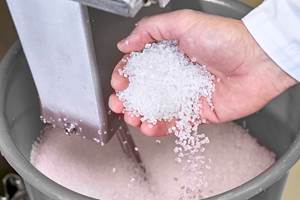Evonik Looks to Extend the Service Life of Joint Prostheses with PEEK Biomaterials
A collaboration between Evonik and Boston’s Mass. General’s Harris Orthopaedics Laboratory is underway to transfer innovation from veterinary to human medicine
Evonik is exploring the possibilities of using the high-performance polymer Vestakeep PEEK, a proven implant material for medical technology, for complex joint prosthesis systems. The specialty chemicals company is drawing on the expertise of medical specialists at the world-recognized Harris Orthopaedics Laboratory--Center for Knee and Hip Replacement at Massachusetts General Hospital in Boston. If the collaborative innovation succeeds, the service life of Vestakeep based joint prostheses could be significantly extended, consequently reducing revision surgery or years of pain therapy—transferring innovation from veterinary to human medicine.
Evonik's PEEK biomaterial is already being used successfully in the latest generation of hip prosthesis systems for pets such as dogs and cats from the Swiss company KYON. At the heart of the innovative technology is a friction partner made of Evonik's Vestakeep PEEK biomaterial with an additional carbon-fiber-reinforced PEEK ring between the ceramic head and the cup. Unpublished data indicate that linear wear is reduced by a factor of 7 with ceramic on PEEK compared to conventional pairings.
Approximately 6000 successfully performed hip replacement procedures without a single revision due to inlay wear and just as many satisfied dogs - including true champions (agility dogs) - as well as five years of careful documentation confirm the success of KYON's PEEK-based hip replacement system. Among other things, Evonik's polymer experts would like to transfer the material expertise and application understanding from veterinary applications with potential medical device manufacturers to human medicine.

Joints are complex movement systems that fulfill important anatomical functions and are constantly exposed to heavy stress. At the Medical Device Competence Center in Birmingham, Alabama, Evonik is pursuing the approach of analyzing the weak points of the joint prosthesis systems already established on the market in human medicine and developing a solution with its high-performance PEEK polymer.
Said Marc Knebel, head of Evonik’s medical systems market segment. "We are looking into the use of Vestakeep in human joint prostheses to improve the quality of life for patients. For example, we have learned to understand PEEK as a material component in complex joint prosthesis systems that can be integrated into existing technologies according to the modular principle.“
Today's joint prosthesis systems are convincing in terms of availability and reliability. However, friction partners - so-called inlays such as those between the head and the cup of a hip prosthesis anchored in the bone - are a primary weak point of current technologies. According to Evonik’s Knebel, the company’s tribological PEEK biomaterial could make the decisive difference in the future and extend the service life of a hip prosthesis fourfold.
If it were, millions of patients worldwide could do without years of pain-relieving therapies. These are often necessary to reach a certain age for surgery, so that the probability of a risky revision at an advanced age can be reduced.
Said Knebel, "The regulatory approval process in human medicine is strictly oriented towards added value for patients. We have to provide sufficient evidence of this added value to attract partners for further development steps. For this reason, we cooperate with Massachusetts General Hospital in Boston, test our material for tribological properties in their professional laboratories and receive valuable feedback that always takes us one step further."
Orhun K. Muratoglu, PhD, director of the Harris Orthopaedics Laboratory and director of the Technology Implementation Research Center (TIRC) at the Massachusetts General Hospital in Boston and Professor of Orthopedic Surgery at the Harvard Medical School noted, “At the Harris Orthopaedics Laboratory we used our state-of-the art in-vitro wear testing machines to evaluate the performance of medical grade PEEK formulations for orthopedic joint replacement applications such as hip and knee implants and found that UHMWPE-PEEK pair has similar or better performance than that of the gold standard UHMWPE-CoCr pair.”
Related Content
Prices Up for All Volume Resins
First quarter was ending up with upward pricing, primarily due to higher feedstock costs and not supply/demand fundamentals.
Read MorePrices Up for PE, PP, PS, Flat for PVC, PET
Trajectory is generally flat-to-down for all commodity resins.
Read MoreThe Fantasy and Reality of Raw Material Shelf Life: Part 2
For the vast majority of thermoplastics, the stability of the materials can be stated in years, not months. But there are exceptions where shelf life can be a serious issue.
Read MorePrices for PE, PS, PVC, PET Trending Flat; PP to Drop
Despite price increase nominations going into second quarter, it appeared there was potential for generally flat pricing with the exception of a major downward correction for PP.
Read MoreRead Next
Beyond Prototypes: 8 Ways the Plastics Industry Is Using 3D Printing
Plastics processors are finding applications for 3D printing around the plant and across the supply chain. Here are 8 examples to look for at NPE2024.
Read MoreLead the Conversation, Change the Conversation
Coverage of single-use plastics can be both misleading and demoralizing. Here are 10 tips for changing the perception of the plastics industry at your company and in your community.
Read MoreFor PLASTICS' CEO Seaholm, NPE to Shine Light on Sustainability Successes
With advocacy, communication and sustainability as three main pillars, Seaholm leads a trade association to NPE that ‘is more active today than we have ever been.’
Read More













